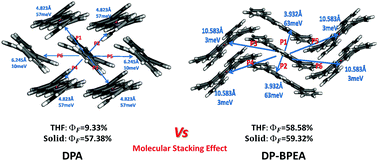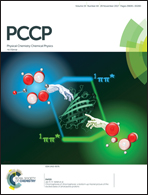Molecular stacking effect on photoluminescence quantum yield and charge mobility of organic semiconductors†
Abstract
The photoluminescence quantum yield (PLQY) and charge transfer property of the high mobility emissive organic semiconductors, 2,6-diphenylanthracene (DPA) and 2,6-diphenyl-9,10-bis(phenylethynyl)anthracene (DP-BPEA), are theoretically investigated. A quantum mechanics/molecular mechanics (QM/MM) method is adopted to investigate the photophysical properties, the Marcus equation is used to describe hole and electron transfer rates, and kinetic Monte Carlo simulation is performed to obtain charge mobility. In both solution and solid phase, the PLQY and the charge mobility of DPA and DP-BPEA are calculated, and the molecular stacking effect is analyzed. For DPA, the rotation motions of the terminal phenyl ring are obviously restricted in the solid phase, which results in the decrease of the Huang–Rhys factor and reorganization energy. This restricted intramolecular rotation (RIR) effect suppresses dissipation pathways of the excited state energy. As a result, the aggregation induced enhancement emission (AIEE) is thus revealed for this emitter from the tetrahydrofuran (THF) solution to the solid phase. However for DP-BPEA, the geometrical variations between the ground and excited states are almost unchanged from the THF solution to the solid phase, and only a restricted intramolecular vibration (RIV) of bond length (e.g. –C![[triple bond, length as m-dash]](https://www.rsc.org/images/entities/char_e002.gif) C–) is displayed. As RIV is not obvious as RIR, a similar fluorescence efficiency is obtained for DP-BPEA in THF solution and the solid phase. In addition, DPA and DP-BPEA crystals are proven to be p-type semiconductors. The calculated mobility of the hole for DPA (3.39 cm2 V−1 s−1) is larger than that of DP-BPEA (1.62 cm2 V−1 s−1) because the number of effective transition pathways of DPA is more than that of DP-BPEA. Our study demonstrates that the different molecular stacking of organic semiconductors has an important effect on their photophysical and charge transfer properties.
C–) is displayed. As RIV is not obvious as RIR, a similar fluorescence efficiency is obtained for DP-BPEA in THF solution and the solid phase. In addition, DPA and DP-BPEA crystals are proven to be p-type semiconductors. The calculated mobility of the hole for DPA (3.39 cm2 V−1 s−1) is larger than that of DP-BPEA (1.62 cm2 V−1 s−1) because the number of effective transition pathways of DPA is more than that of DP-BPEA. Our study demonstrates that the different molecular stacking of organic semiconductors has an important effect on their photophysical and charge transfer properties.



 Please wait while we load your content...
Please wait while we load your content...